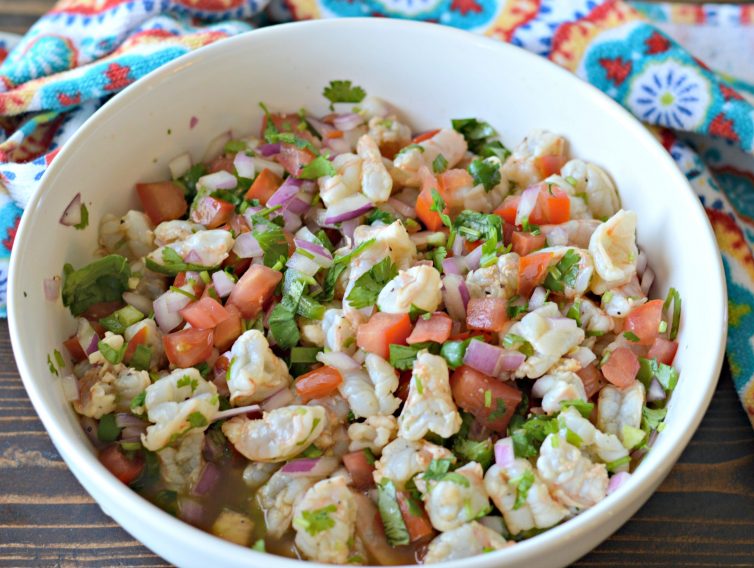By Addie Broyles, Austin American-Statesman
There’s no better time to try making ceviche at home than when it’s the dead of summer, that lovely season when it’s too hot and dry to grill.
In an attempt to escape the Texas heat, I headed to Playa del Carmen a few weeks ago for one last vacation before the school year began. I expected to find plenty of fish dishes, but I didn’t expect to find restaurants serving ceviche, aguachiles and cocteles by the kilo.
We ate these no-cook fish dishes nearly every day of the trip, some barely soaked in lime juice and served in a giant molcajete and others served on a shallow plate and in a spicier marinade.

The kinds of ceviches in the Yucatán are only a slice of what’s served throughout Central and Latin America, where you’ll find endless mixtures of fish (and shellfish, octopus and other seafoods) “cooked” in citrus juice and tossed with other ingredients, from the Peruvian tiradito to the ketchup-based campechana from the Mexican state of Campeche.
“And I like them all,” says Fonda San Miguel executive chef Caesar Ortiz.

Ortiz grew up eating ceviche in El Paso that tastes a lot like the ceviche he serves at Fonda San Miguel, the venerable Austin restaurant that opened in 1976: a traditional mix of tomatoes, jalapenos or serranos, cilantro, lime juice and chopped fish, usually drum.
It wasn’t until he went to San Antonio during the summers to stay with his aunt and uncle that he started trying different varieties, including campechana: a mix of shrimp, fish and oysters served in a liquid made with lime juice, clam juice, oyster juice and ketchup.
Then, a family trip to Mazatlán for Thanksgiving when he was in high school introduced him to aguachile, the freshest of the ceviches that is popular in Sinaloa and other coastal regions of Mexico.
“We went deep-sea fishing with my grandfather and uncles and had right-out-of-the-ocean butchered fish mixed with lime juice and chiles,” he says. “It was a truly raw preparation with acid, salt and heat, and that’s when I realized that I like this much better than anything else.”
To this day, Ortiz prefers a lightly cured ceviche, especially an aguachile, over sushi or poke, the Hawaiian raw fish dish that has become popular in the continental U.S. in recent years.
“That’s the beauty of ceviche,” he says. “If you have access to super fresh seafood, you can simply chop it up and squeeze lime juice on it and eat it instantly.”
Peruvian-style ceviche is one of the less-cooked styles, and it’s usually served with leche de tigre, or a mix of pureed aji amarillo with lime juice and maybe some lemon juice or clam juice.
In many regions of Central and Latin America, you’ll find dishes that were influenced by Japanese and Chinese cooks who moved to the region for jobs or to avoid wars. That’s why many aguachiles have soy sauce or sesame oil and why the Peruvian tiradito often includes wasabi or pepper puree.
The fish, shrimp and shellfish dishes with tomato-based sauces have traditionally been used to cure hangovers, not unlike a bloody mary or a michelada, and some cevicherias will serve a coctel with beer, lime juice, ketchup and Clamato in a salt-and-shrimp-rimmed glass. (One regional specialty from Veracruz is called Vuelve a la Vida, or “return to life.”)
Ortiz says that when you’re making ceviche at home, start with the freshest fish you can find, from snapper or drum to flounder, salmon or tuna. Because the citrus juice doesn’t technically cook the seafood, make sure you’re using sushi grade, and don’t use freshwater fish, such as tilapia or catfish. To prepare the fish, all you have to do is remove the skin and cut the fish into small cubes or thin slices. Some cooks like to salt the fish, shrimp or scallops first to season the meat before tossing in the marinade.
Shrimp is also a good choice, but avoid the previously frozen ones that have already been soaked in salt water. You can also use squid or octopus, but skip the scallops that are sold in a milky liquid; dry-packed scallops are more expensive, but they aren’t treated with chemicals or a brine.
For the marinade, use freshly squeezed lime juice for the majority of the liquid, but you can also add a little lemon or orange juice for sweetness. Some regional variations call for a little olive oil or vinegar, but don’t use balsamic or another concentrated vinegar. Aguachile means “chile water,” and to achieve the desired spiciness, you can soak the seafood mixture with sliced chiles or you could crush the chiles with lime juice and a little water in a molcajete or a mortar and pestle to add to the marinade.
Once you combine the seafood and the marinade, refrigerate the mixture for just a few minutes or up to several hours, depending on how “cooked” or cured you prefer the dish.
Inspired by some of the restaurants we enjoyed in the Yucatan, I’ve been adding avocado and cucumber to the ceviches I’ve tried making at home, including an aguachile made with tuna, sesame oil and soy sauce. Almost every restaurant we went to in Playa del Carmen served ceviche with homemade totopos, or corn tortilla chips that were as thick as tostadas. A thicker chip is better, but in many places, it’s customary to serve ceviches, coctels and the like with saltine crackers.
Oddly, that’s what was always served with the shrimp cocktails I grew up eating, even though we were so far from the ceviches of El Paso and Juarez that were familiar to Ortiz.
“That’s what makes ceviche so great,” he says. “There are just so many ways to make it.”
Ceviche
Don’t use freshwater fish for ceviche, including tilapia or catfish. Everything else is up to you, just make sure the seafood is fresh. I like to add avocados and cucumbers, and you can use a store-bought pico de gallo.
— Addie Broyles
1 pound mix of white fish, tuna, salmon, shrimp, scallops or octopus, cut into small-to-medium cubes
1/2 cup fresh lime juice
2 tablespoons lemon juice
1/2 cup sliced cucumber (optional)
1/2 avocado, cubed (optional)
1/2 cup cubed tomatoes
1/4 cup diced or sliced white or red onion
1 tablespoon chopped cilantro
Salt, to taste
Chips or tostadas, for serving
Mix the seafood with the lime and lemon juice in a nonreactive bowl. Let sit for at least 30 minutes or up to two hours. Add the cucumber and avocado, if using, tomatoes, onion and cilantro. Season to taste with salt. Let sit for another 15 minutes and then serve with the chips or tostadas.
— Addie Broyles
Scallop Aquachile With Tomato-Habanero Water and Gooseberries
Aguachile is a ceviche traditionally made in the Mexican state of Sinaloa with fresh raw shrimp, cucumber, red onion, lime juice and chiles, and it’s a great summer dish to enjoy with a cold beer and a wedge of lime. It isn’t exactly a Tex-Mex dish, but my family made a version of it: We would take the liquid from a bowl of pico de gallo and pour it over raw shrimp. At Bar Amá, we make with it with scallops during tomato season. The kitchen makes tomato water from fresh tomatoes and habanero chiles and pours that and lime juice over raw scallops, pickled gooseberries, cucumbers and shallots. Aguachile is traditionally served immediately, without marinating, but if you want the acid in the lime juice and vinegar to slightly “cook” the seafood, you can marinate it for a bit. Pineapple and banana vinegars are available at some gourmet shops and online, such as at the Rancho Gordo website. We serve this dish with pickled gooseberries, which can be hard to find in some places. Just leave them out if you can’t easily find them.
— Josef Centeno
For tomato-habanero water:
1 pound cherry tomatoes
1 shallot, chopped
1 large garlic clove
1 habanero chile, stemmed and seeded
1/2 cup fresh cilantro leaves
10 fresh basil leaves
3 tablespoons pineapple vinegar or distilled white vinegar
1 tablespoon fine sea salt
12 ounces sea scallops (about 12), side muscle removed
2 tablespoons fresh lime juice
1/2 lemon cucumber, thinly sliced
12 pickled gooseberries (recipe follows), halved (optional)
1 shallot, thinly sliced into rings
1 serrano or jalapeño, stemmed, thinly sliced into rings, and seeded
Finely chopped fresh cilantro leaves for garnish
Extra-virgin olive oil for drizzling
Flaky sea salt and fresh black pepper
Line a fine-mesh sieve with cheesecloth and set it over a large bowl. Make the tomato-habanero water: Combine the tomatoes, shallot, garlic, habanero, cilantro, basil, vinegar and fine sea salt in a food processor and pulse until coarsely chopped. Transfer the mixture to the prepared sieve. Cover and refrigerate for at least 2 hours and up to 4. (Do not stir or press on the solids, or the tomato water will be cloudy.) Discard the solids, cover the tomato water and refrigerate until ready to use.
Cut each scallop crosswise into thirds so that you have three thin, round slices. Put the scallops in a medium bowl and pour over the lime juice and tomato water. Serve immediately, or if you wish, marinate the scallops for 1 to 3 hours in the refrigerator.
To serve, divide the scallops and the juice and tomato water among 4 to 6 shallow bowls. Add the cucumber, and arrange the scallop and cucumber slices attractively. Top with the pickled gooseberry halves, if using, shallot and chile. Garnish with cilantro leaves and a drizzle of olive oil. Season with flaky sea salt and a grind of fresh black pepper and serve. Serves 4 to 6.
Pickled Gooseberries
Found at farmers markets and in sunny backyards, Cape gooseberries have a sweet-tart flavor, which tastes like a combination of cherry tomato, pineapple, mango and Meyer lemon. Like tomatillos, they have a husk you have to remove before using. They’re a good match with pickling spices — here, a little coriander, star anise, allspice and pepper. And the pickling process really works its magic on the gooseberries, rounding out their tartness. Add these as a puckery condiment to salads, ceviches, and roasted and grilled meats — anything that could use a little fruity acidity.
— Josef Centeno
1/4 teaspoon coriander seeds
3 whole allspice
1 star anise
1 teaspoon black peppercorns
1/3 cup Champagne vinegar
1/3 cup water
1/3 cup sugar
A few fresh cilantro leaves
Pinch of fine sea salt
2 cups gooseberries, husked and halved
In a small, dry skillet, toast the coriander, allspice, star anise and black peppercorns over medium heat, stirring frequently, until they begin to release their oils and are fragrant, about 2 minutes. Set aside.
Combine the vinegar, water and sugar in a saucepan and bring to a boil. Remove from the heat, add the spices and set the mixture aside to cool to room temperature.
Put the halved gooseberries in a container. When the vinegar mixture is cool, pour it over the gooseberries. Cover and refrigerate for at least 1 hour before using. Store, covered, in the refrigerator for up to 1 week. Makes 4 cups.



